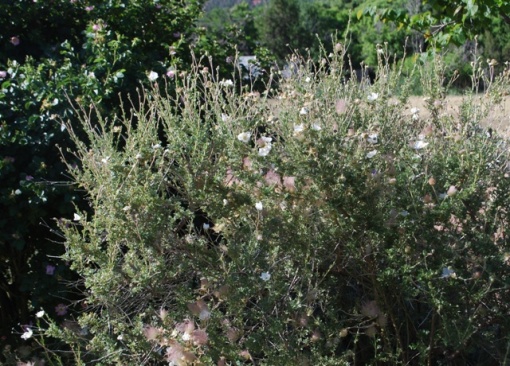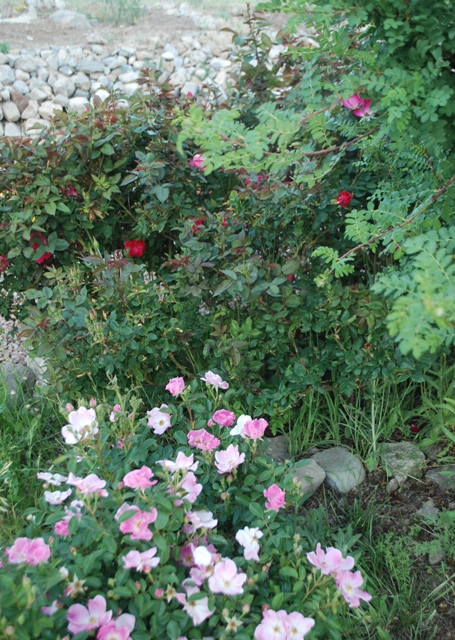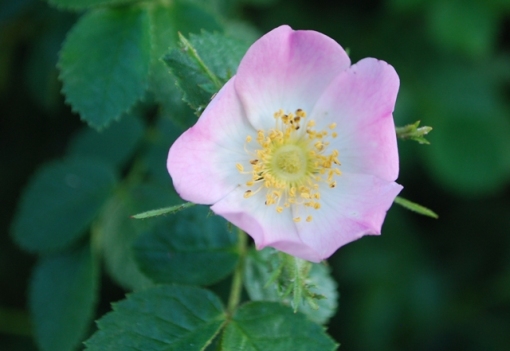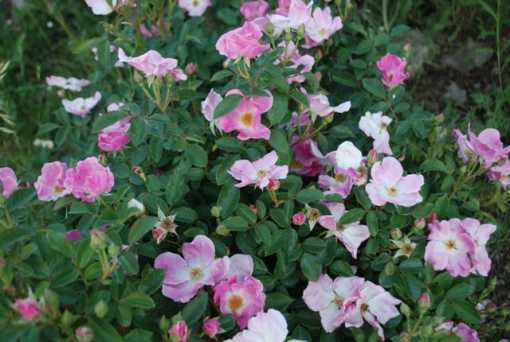Roses are old-fashioned favorites that often remind gardeners of their mothers or grandmothers or of lush gardens in the South, where both water and sun were readily available from nature. But I see fewer roses in gardens now, partly because they’re associated with lots of patience and care, and partly because some of the hybrid roses need more water than a low-water garden can – and should – provide. It’s also strange to picture a tall, hybrid tea rose in the middle of a xeric landscape, although a good landscape designer can always work a small rose garden into your plan if that’s what you desire.

Friends brought us this floribunda as a housewarming gift and it fits nicely in our xeric rose garden. We watered it the first year, but only a little this spring.
Many shrub-size roses fit in nicely with the look and purpose of a low-water garden. So you can have the scent and many other features of roses, as long as you’re willing to choose the right type of rose. Here are a few to consider:
Species roses. A species rose is basically a wild rose. Several species roses have grown to adapt to drought and other extreme conditions. I have several in my rose garden area, and I know one of them is a Wood’s rose (Rosa Woodsii). It can grow to at least 10 feet and has beautiful pink flowers, followed by hips all fall and winter, which the birds love. Another is a shorter, shrub-style rose that I believe is the Prairie rose (Rosa blanda), with pink flowers that fade to white in the center. The other has deep red flowers. Both have in common large, plentiful thorns and bunches of two-inch flowers in late spring.
Native roses. In New Mexico and other Southwestern states, the Arizona Rosewood (Vauquelina californica), which resembles an evergreen oleander in its foliage and shape, or the Apache Plume (Fallugia paradoxica) both have delicate white flowers that resemble roses. The native plants have adapted to the Southwest and attract bees.

This Apache plume (with the Wood’s rose in left background) got too dense and full. They are so easy to care for and forgiving when pruned.
Shrubs and groundcovers. Some hybrid roses have been adapted to grow as smaller shrubs and groundcovers. They’ll use less water and take up less space in the landscape. In general, they need less care than other rose types, but have long bloom periods.

Flower Carpet Red from Tesselaar is a spreading groundcover rose that reaches no more than 32 inches high. It’s drought tolerant once established and hardy down to zone 5. Image courtesy of Tesselaar.
In fact, species, native and certain shrub or groundcover roses are all typically easier to care for and relatively disease free. Just give them mostly sun and prune according to recommendations once in early spring. You don’t have to continuously dead-head blooms, and they have adapted to lower water and the changing conditions of high deserts and mountains, so having them in your garden is more water wise. But there are a few disadvantages. The species roses are wild, which means they can sprout new canes or offshoots. The yellow one in our garden has gotten too thick and large, and will need serious pruning next spring; it’s sort of taken over the area and is shading some other plants too much.

Our rosa blanda, red species rose and taller yellow species rose to the right. It blooms earlier than the others, so we have color from early May through September.
Another disadvantage is that if you love to cut long rose stems to use the blooms in flower arrangements, you won’t enjoy these varieties as much as hybrid tea roses; their stems are typically shorter. However, if you want to walk or sit next to them in your garden and stop to smell them, or simply enjoy the beauty of the plant and blooms, you can have your roses and save water too!

